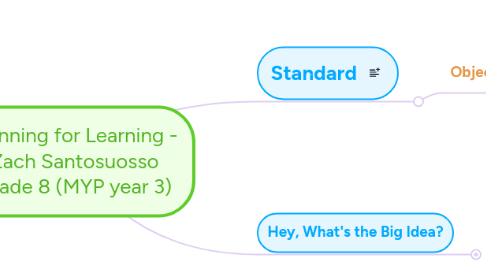
1. Standard
1.1. Objectives
1.1.1. #1 - Identify the purpose of each sentence in a paragraph
1.1.1.1. a. Model (I do it) – using a document camera, I will model for students how to go through and identify the different types of sentences in a paragraph b. Checklists – students will be given a checklist of things to look for when identifying a topic sentence, evidence sentence, or explanation sentence
1.1.2. #2 - Write an analytical paragraph
1.1.2.1. a. Mind map – have students create a mind map for their topic, giving 2-4 supporting evidences, plus an explanation for each evidence. b. Template – students a low readiness levels can write their paragraph using a template. Even lower students can use a template that contains sentences starters.
1.1.3. #3 - Identify and write a thesis statement
1.1.3.1. Compare and contrast – students will be shown a single paragraph and a 5-paragraph essay. As a class, we will create a Venn diagram to compare and contrast the thesis statement and the topic sentence.
1.1.4. #4 - Identify the purpose of each paragraph in a 5-paragraph essay
1.1.4.1. a. Release of responsibility – step 1, I model for students how to identify the purpose of a paragraph (e.g. ‘this is a body paragraph that discusses argument #1 because…. etc.’). Step 2, students identify the purpose of paragraphs using an answer bank (i.e. matching paragraphs to pre-existing identifications). Step 3, students write their own identifications of the paragraphs.
1.1.5. #5 - Write a 3-5 paragraph essay
1.1.5.1. a. Outline – students create an outline of their essay to develop their organizational skills (lower readiness students can use a pre-made outline and fill it in) b. Brainstorm template – if students struggle with abstract concepts, or thinking of supporting evidence for a thesis, they can use a brainstorm template that asks them questions designed to help draw out the appropriate information.

